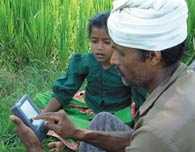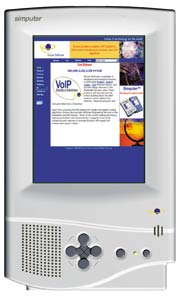|
Technicalities
|
By Fiona Harvey

Image: Courtesy of ENCORE SOFTWARE LTD
FARM WORKERS in Bolare, a village located southwest of Bangalore, India, try out a literacy tutorial program on the Simputer. Because the device can convert text to speech, it can help teach villagers how to read the local language, Kannada.
|
The device is known as the Simputer. I recently got a chance to evaluate one of the preproduction models that have been put together by the Simputer Trust, a nonprofit organization based in Bangalore, India. This year Encore Software, a Bangalore company that licensed the technology from the trust (not to be confused with the California software company of the same name), plans to sell thousands of the handheld devices, capping an effort that began in 1998.
Simputer stands for " simple, inexpensive, multilingual computer." It was designed to meet the needs of rural villagers in countries such as India, Malaysia, Nigeria and Indonesia. Many of these potential users are illiterate and have never even seen a computer before. Loaded with some elementary software, the Simputer will sell for about $250 (or $300 for a model with a color screen). That's a sizable chunk of the yearly per capita income in many developing nations. But the Simputer's proponents argue that a single device could enable an entire village to access the Internet, perform transactions, keep track of agricultural prices and educate its children. Says Shreyas Patel, a consultant to Encore who has been setting up pilot tests of the Simputer in East Africa: " This will bring computing power to isolated communities. It can have an enormous impact."
The Simputer was conceived by a team of computer scientists at the Indian Institute of Science in Bangalore. To make the machine cheap enough to sell in poor regions, the developers kept the hardware requirements to a minimum. The Simputer's microprocessor is an Intel Strong-ARM chip, which is known for its low power consumption. The device will have as much as 64 megabytes of random-access memory and 32 megabytes of flash memory, as well as a modem that can connect to a telephone line. And the computer runs on the Linux operating system, which is available free of charge.
Like the Palm, the Visor and other personal digital assistants (PDAs), the Simputer has a touch-sensitive screen. You use a stylus to tap on icons and to input information. The device doesn't have a keyboard or handwriting-recognition software, but in certain applications the user can select letters or numbers from a software-generated keyboard that pops up on the screen. In addition, the Simputer has a program called Tapatap that displays a three-by-three grid; you can input a letter or number by tapping on the squares of the grid in a particular sequence. Although this method is easier than hunting and pecking on a software keyboard, it is still somewhat laborious, so the Simputer's applications have been carefully designed to minimize the need for tapping in text.

Image: Courtesy of ENCORE SOFTWARE LTD
PREPRODUCTION MODEL of the Simputer has a black-and-white screen and built-in speakers. A Bangalore company named Encore Software plans to sell the device for about $250.
|
I was unable to test this function on my preproduction model, which lacked the text-to-speech program. I can confirm, however, that the Simputer is remarkably easy to use. Its screen is free of the annoying graphical clutter that most of us are accustomed to seeing on our PCs. Below the screen are seven small buttons, one an on-off switch and the rest for use with certain embedded applications such as the Tapatap program. I found that I did not need to bother with the buttons very often, because the design of the software made it easier to use the stylus.
The Simputer also has a slot for " smart" cards, a feature that its makers see as crucial. Because the device lacks a hard drive, smart cards will act as the device's portable storage units. In this way, many people will be able to share a single Simputer without having to share their private information with one another. The cards will cost between $1 and $3 apiece and will hold four to eight kilobytes of data-- not very much by commercial standards but enough to carry some basic information for each user. " We envisage that a village might club together to buy one," notes Shashank Garg, vice president for product development at Encore. A farmer in India, for example, could use the Simputer to find out the latest prices for cotton, allowing him to strike a better deal when selling his crop. The next day one of his neighbors could use the same device to examine government property records, eliminating the need to make a difficult journey to the city.
The Simputer Trust believes the range of applications will prove compelling. But the device does have some drawbacks. It's slow, taking about 15 seconds to boot up and often needing several seconds to digest the information that the user inputs. And the Simputer sometimes crashes when it is left idle for a while, making it necessary to reboot the machine. Also, powering the device may be a daunting task in areas that do not have a reliable electricity supply. Although the Simputer can run on three AAA batteries, it can operate for only a few hours before draining them. And in the developing world, even batteries are expensive and hard to come by.
Fortunately, Simputer users may be able to draw on muscle power instead. A decade ago English inventor Trevor G. Baylis created the Freeplay radio, which is powered by turning a crank that winds up a spring inside the machine. As the spring unwinds, it turns a shaft that runs a small electric generator. Freeplay Energy Group, the company that now sells these radios, recently produced a similar charger that can power a mobile phone. In a demonstration this year some energetic hand-cranking yielded enough energy to run an Apple laptop for a few minutes. With a few adaptations, devices such as these could charge up the Simputer.
But the Simputer may not be the best tool for bringing information to the world's poorest nations. Because most people in developing countries have no access to fixed telephone lines, many mobile-phone operators are setting up networks in those areas. Mobile phones are cheaper than the Simputer, and the most advanced models can send text messages and access the Internet. Communities choosing between the devices may find a mobile phone more immediately attractive for keeping in touch with the outside world and conducting business.
Perhaps the greatest obstacle for the Simputer, though, is cost. Will people in developing countries be able to justify the expenditure of $250 on a device that may be helpful but is not essential? When so many communities in the Third World still lack clean drinking water and adequate medical facilities, are computers really a priority?